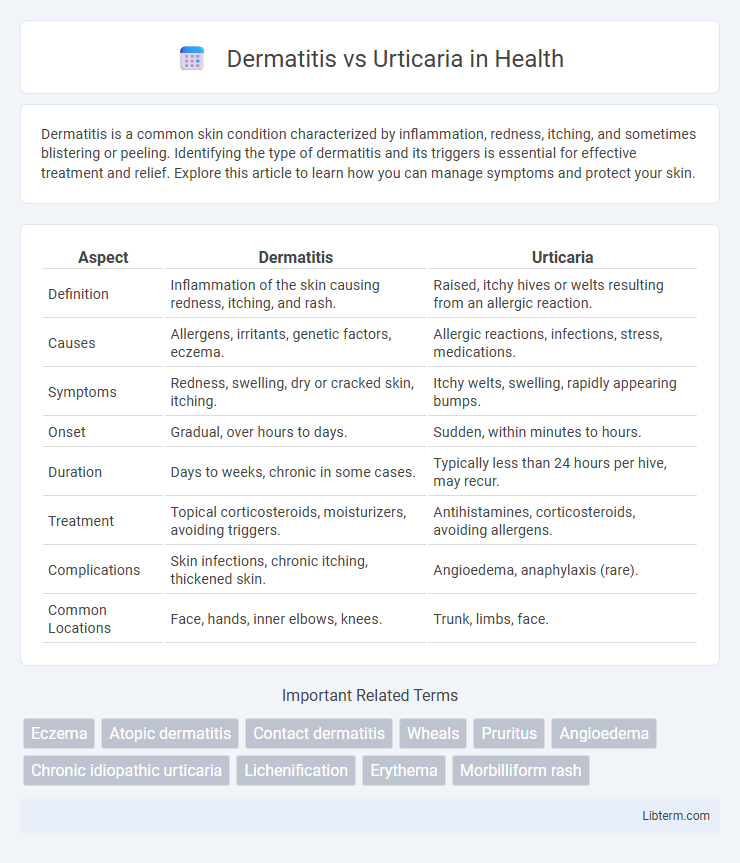Dermatitis is a common skin condition characterized by inflammation, redness, itching, and sometimes blistering or peeling. Identifying the type of dermatitis and its triggers is essential for effective treatment and relief. Explore this article to learn how you can manage symptoms and protect your skin.
Table of Comparison
| Aspect | Dermatitis | Urticaria |
|---|---|---|
| Definition | Inflammation of the skin causing redness, itching, and rash. | Raised, itchy hives or welts resulting from an allergic reaction. |
| Causes | Allergens, irritants, genetic factors, eczema. | Allergic reactions, infections, stress, medications. |
| Symptoms | Redness, swelling, dry or cracked skin, itching. | Itchy welts, swelling, rapidly appearing bumps. |
| Onset | Gradual, over hours to days. | Sudden, within minutes to hours. |
| Duration | Days to weeks, chronic in some cases. | Typically less than 24 hours per hive, may recur. |
| Treatment | Topical corticosteroids, moisturizers, avoiding triggers. | Antihistamines, corticosteroids, avoiding allergens. |
| Complications | Skin infections, chronic itching, thickened skin. | Angioedema, anaphylaxis (rare). |
| Common Locations | Face, hands, inner elbows, knees. | Trunk, limbs, face. |
Understanding Dermatitis: Definition and Types
Dermatitis is an inflammatory skin condition characterized by redness, swelling, and itching, with common types including atopic dermatitis, contact dermatitis, and seborrheic dermatitis. Atopic dermatitis is a chronic, relapsing condition often linked to allergies and asthma, whereas contact dermatitis results from direct skin exposure to irritants or allergens. Seborrheic dermatitis primarily affects oily areas of the skin, such as the scalp and face, causing flaky, scaly patches distinct from urticaria, which involves transient hives caused by allergic reactions.
What Is Urticaria? Key Features Explained
Urticaria, commonly known as hives, is characterized by raised, itchy welts that appear suddenly on the skin, often triggered by allergic reactions, infections, or stress. These wheals typically vary in size and shape, blanch under pressure, and resolve within 24 hours without scarring. Unlike dermatitis, which involves prolonged inflammation and may cause dry, scaly patches, urticaria primarily affects the superficial layers of the skin and is usually a transient immune response.
Causes of Dermatitis vs Urticaria
Dermatitis is primarily caused by prolonged exposure to irritants or allergens such as soaps, detergents, and certain metals, which trigger an inflammatory skin reaction. In contrast, urticaria (hives) results from the release of histamine and other chemicals during an allergic reaction to factors like foods, medications, insect stings, or infections. While dermatitis involves a delayed hypersensitivity response, urticaria is typically an immediate hypersensitivity or immunologic reaction.
Common Symptoms: How They Differ
Dermatitis primarily presents with red, inflamed, scaly skin accompanied by itching and sometimes oozing or crusting, indicating a prolonged inflammatory response. Urticaria, or hives, manifests as raised, itchy wheals or welts with sudden onset and transient nature, usually fading within 24 hours without leaving marks. Unlike dermatitis, urticaria often causes swelling (angioedema) and rapid appearance, highlighting distinct immune mechanisms behind each condition.
Diagnosis: Identifying Dermatitis and Urticaria
Dermatitis diagnosis involves clinical evaluation of skin inflammation characterized by redness, itching, and scaling, often confirmed through patient history and patch testing to identify allergens. Urticaria diagnosis relies on identifying transient, raised, and itchy wheals on the skin, with a key diagnostic criterion being the rapid onset and resolution of hives, sometimes supported by blood tests to detect underlying triggers. Differentiating these conditions requires careful assessment of lesion duration, appearance, and response to treatments to ensure accurate identification and management.
Risk Factors for Each Condition
Dermatitis risk factors include prolonged exposure to irritants, allergens, genetic predisposition, and compromised skin barrier function, often seen in conditions like atopic dermatitis or contact dermatitis. Urticaria risk factors involve allergic reactions to foods, medications, insect stings, infections, stress, and autoimmune conditions that trigger histamine release causing hives. Both conditions require identifying and managing specific triggers to prevent flare-ups and minimize chronic symptoms.
Treatment Options for Dermatitis
Treatment options for dermatitis primarily include topical corticosteroids, emollients, and antihistamines to reduce inflammation and itching. In more severe cases, immunosuppressants or phototherapy may be prescribed to control symptoms and prevent flare-ups. Proper skin care routines and avoidance of irritants are essential components of effective dermatitis management.
Urticaria Management and Relief Strategies
Urticaria management centers on identifying and avoiding triggers such as allergens, stress, and medications to prevent flare-ups. Antihistamines are the primary treatment to reduce itching and swelling, while corticosteroids may be prescribed for severe cases. Supportive care includes wearing loose clothing, using cool compresses, and maintaining a hypoallergenic skincare routine to alleviate symptoms effectively.
Prevention Tips for Both Conditions
Preventing dermatitis and urticaria involves avoiding known triggers such as allergens, irritants, and extreme temperatures to reduce flare-ups. Maintaining proper skin hydration with fragrance-free moisturizers and wearing protective clothing minimizes irritation and allergic reactions. Regularly cleaning living spaces and using hypoallergenic products also help decrease exposure to potential allergens, supporting skin health in both conditions.
When to Seek Medical Attention
Seek medical attention for dermatitis when symptoms include intense itching, spreading rash, swelling, or signs of infection such as pus or fever. For urticaria, urgent care is necessary if hives are accompanied by difficulty breathing, swelling of the face or throat, dizziness, or chest pain, which may indicate a severe allergic reaction or anaphylaxis. Persistent, recurrent, or unexplained skin eruptions in both conditions warrant evaluation by a dermatologist to determine appropriate treatment and prevent complications.
Dermatitis Infographic

 libterm.com
libterm.com